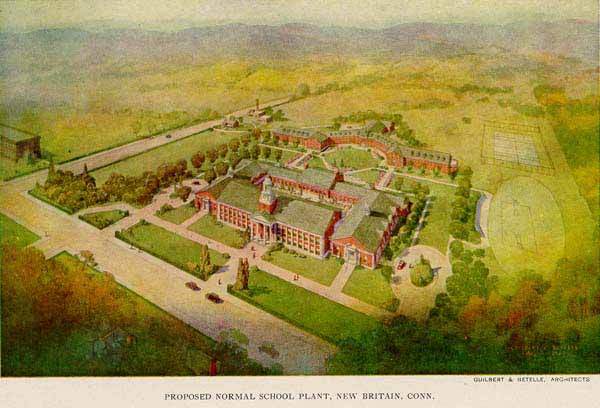

|
The library was located in what is today known as Founders Hall.

|
| With Mary E. Goodrich's retirement in 1920 Esther S. Pihl became librarian and instructor of history and library methods. She would serve until 1927. | |

|
In 1927 Katherine Morgan Strong was appointed librarian. Miss Strong would
remain at the school for fifty years.
She recalled driving a horse and wagon loaded with library books from the Walnut Hill building to the new campus. |
Students continued to receive free textbooks, and the library now held 10,000 books.
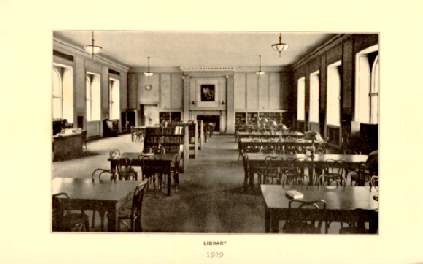
| The 1929 catalogue stated that "the students are trained to use the library through a course covering 18 periods in the junior year. Most lessons assigned are topical, and must be studied by the use of references given by instructors." By 1931, a one semester hour course in library methods was being offered to first-year students. |
| Library Interior, 1929 |
The two corridors leading to the library, known as the sunrooms, contained lockers for the students. The library annex off the corridor served as a reading room. It was limited to fifth year students, prompting an anonymous "undergraduate" to write a letter to the Central Recorder on November 9, 1934. The writer complained about the " great lack of recreational room on this campus." Apparently there was enough widespread dissatisfaction about this situation that the October 11th, 1935 issue of the Recorder could report that "Library Improvements Soon to be made." As a first step, book stacks would line the corridors and study tables would be added. The article announced that in the next few years the two women's locker rooms would be converted into a stack room and seminar room, respectively.

|
The depression years were especially difficult for the school in general and the library in particular. In 1939, the New Britain Herald reported that only $35 had been allocated for library books. The article stated that only 15 or 16 books could be purchased for the year. The school catalogues continued to run a request for book donations. Mary E. Goodrich, the former librarian, had created a fund which allowed for the acquisition of about twenty-four books per year.
The library also entered into a working agreement with the New Britain Institute (The Public Library) for the use of books because of the inadequate stock in the college library. The legislature had so severely cut the appropriations that expenditure per pupil had dropped from $500 in 1932 to $234.01 seven years later. Dr. George Muirhead reported that multiple copies of unsold textbooks were sent by the bookstore to be added to the library's collection. Finally the staff of the State Department of Education library loaned many books to the campus.
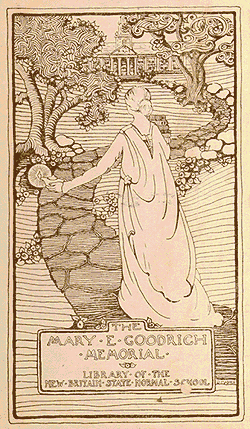
|
Herbert D. Welte became the eighth principal of the Normal school in 1929. In his 1935-1936 annual report, Dr. Welte mentioned that the WPA's National Youth Administration had provided funding for the hiring of student workers. Because of this depression era program, the library was able to hire fifteen students.
During Dr. Welte's first decade, expenditures for library books ranged from a low of $531.31 in 1933-1934 to a high of $2,475.00 in 1939-1940. In 1933 the General Assembly approved the change over from a two-year normal school to a four-year teacher's college.
By the early 1940s space in the library was again at a premium. An editorial in the October 30, 1941, Central Recorder detailed the lack of facilities. "The college library, has been forced ... to serve in the capacity of study hall, conference room, and, of course, library." With the advent of World War II, a War Information library consisting of materials from various government agencies was added to the library.
In 1945 Elizabeth Walden became the assistant librarian, replacing Jane Flener. Miss Walden was also teaching a course in children's literature.
By the late 1940s, Library of Congress card sets were being ordered by the cataloging department. Before the advent of this service, catalog card sets were written or typed.
With the end of World War II enrollment at the college exploded. Through the Federal Works Agency the college obtained a temporary wooden building which had been used as a dining hall during World War II. This building was used to house all but the reference section of the library. This building also housed the industrial arts program and the college bookstore. The reading room remained in the Administration Building.
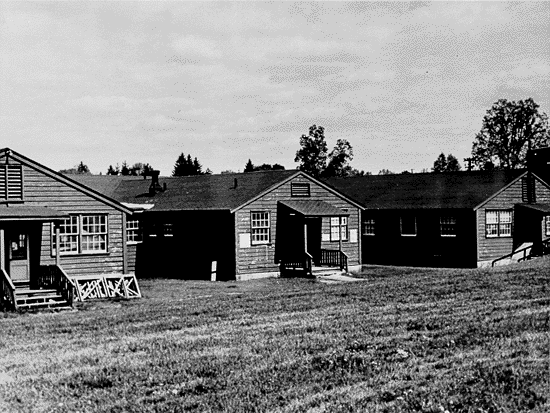
|
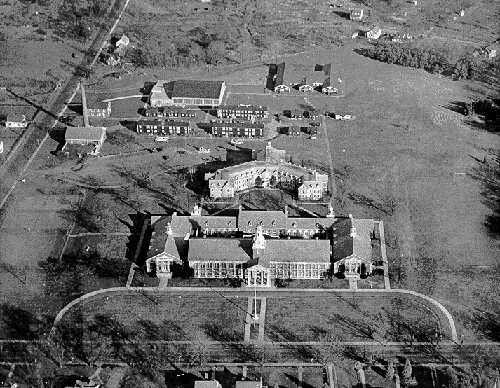
WWII barracks just behind Marcus White dormitory were used for faculty housing. |
On January 24, 1950, the Library Committee issued a report to the Administrative Council. They reported that the $10,000 for the purchase of library books for the year July 1, 1949 to June 30, 1950, had been exhausted by December 1949. In addition there were many requests on hand which could not be honored in the above fiscal year. This resulted in unfilled orders being set aside until the following fiscal year. The problem of unfilled book and serial orders continues to plague the library. The committee did not recommend additional funds for the purchase of books, but instead they recommended that book requests be spread out over the entire year and that greater effort be made to avoid duplicate orders.
By 1951 the library staff consisted of Miss Strong, Robert Massmann, order librarian, Louise Spencer, cataloger, and Miss Walden who headed circulation. In 1951, the entire library was moved to the East Hall structure and that same year a book checkout system was instituted. In the past, books had been removed from the library without being signed out!

| 
| 
|
| Back | Return to main history page | Next |